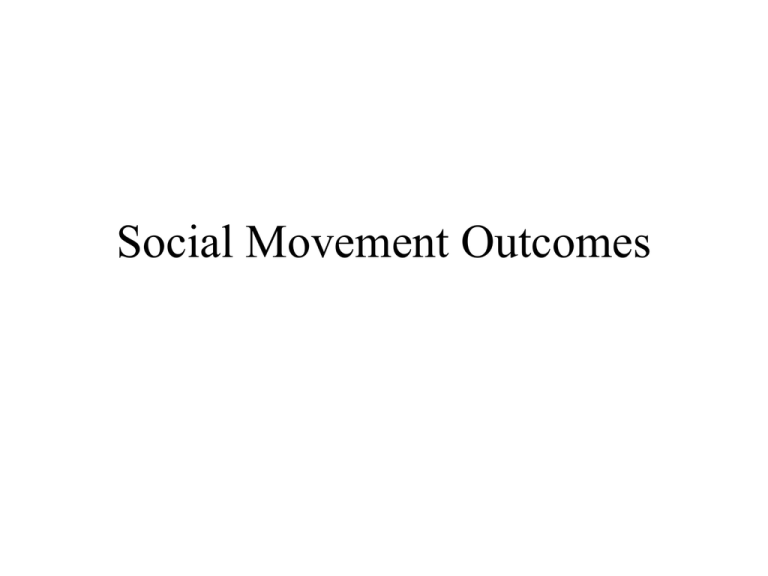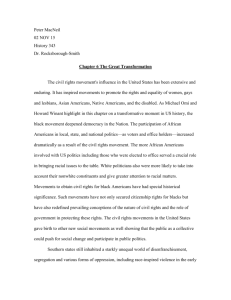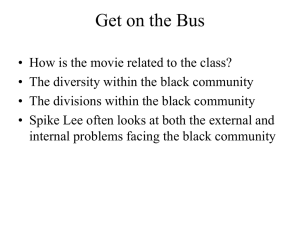Social Movement Outcomes
advertisement

Social Movement Outcomes Examples • Movements such as IWA, Nazism, Women Rights Movements, Anti Globalization movements are a few examples of the importance of social movements and collective action for social change. Right and Left • The large scale changes produced by social movements often depend on the political spectrum- right and left. • Right wing- are usually defeated in some way-you can’t hold back the path of change. • Left wing -grow with society, more inclusive, more organized. Suzanne Staggenborg • The Social Movements • Suzanne StaggenborgISBN13: 9780195375084ISBN10: 0195375084Paperback, 224 pagesJan 2010, In Stock Protest Cycle of the 1960s • Began in the 1950s, with the Civil Rights Movement… • Civil Rights Provided a model for collective action that help spur on a number of other protests including: • Second Wave Feminism, Gay Rights, Environmental Movement, and AntiGlobalization. (Aka Global Justice) Macro level changes • All social movement theories point to the effects of large scale socio-economic and political changes on the outcomes of social movements. • Social movement do not exist in a vacuum. • As a result, many of the `inclusive’ movements we see today emerged during the Protest Cycle of the 1960s’ 1960s • Were made from the 1950s…1950s a conservative time, boys and girls in separate compartments. (instrumental and expressive role-see Parsons) • Many were unaware of racial issues, gays were definitely in the closet, environment not a concern…Build more highway loaded with litter… For example • The Civil Rights Movement-economic changes and the urbanization of Black was occurring. This allowed Black churches to mobilize. • In another example, it was demographic changes, along with the Cold War and problems of Vietnam that allow student of the New Left to organize and be successful. • Once the cycle of protest was underway, new movements were inspired to organize. • Civil Rights Movement inspired the follow movements: Women’s movement, Gay Liberation Movement, Environmental Movement, Anti Globalization Movement Women’s Movement • Another movement inspired by the cycle of protest in the 1960s. • The Second Wave of the Feminist movement was clearly aided by large scale transformations such as the declining birthrate and changes in labour market. • No longer was the stay at home mom economically possible for many. • Women’s movements in Canada and the US had significant success • Staggenborg “their successes may partly explain the relative decline in women’s rights movments-insofar as women had fewer grievances” However • The maintenance of Second Wave groups and the Rise in Third Wave groups indicates that on-going issues such as family violence, reproductive rights continue to mobilize some women. • Also, the countermovement on issues such as abortion and backlash literature has meant the feminist groups continue to have relevance. Gay Liberation Movement • The protest cycle of 1960s created greater public space for sexual minorities • Political opportunities such as the adoption of the Charter of Rights helped Canada • Association for Social Knowledge 1964 gays and lesbian denied basic rights such as employment • By 1971, low key approach early gave rise to Gay Liberation Movement • Since 1971, lobbied for inclusion secured human rights under the Charter 1982 • In 2005, became legal same-sex marriage across Canada Another Outcome • The politics of gov’t that are more centralized like the UK and Canada • Have helped Gay Rights Movement-for example, the Gay Pride Parade –make it appear the the issue has been won. • However, organizers continue to fight for rights in countries such Russia and Iran. Environment Movement • The protest cycle of the 1960s, gave rise to environmental movement. • However, the widespread threats of toxic waste, the destruction of forest, and global warming continue to keep the environmental movement alive. • Dump • Hooker Chemical had sold the site to the Niagara Falls School Board in 1953 for $1, with a deed explicitly detailing the presence of the waste,[1] and including a liability limitation clause about the contamination. This movement continues: • Political opening such in Canada and Germany • Support in the number of Green Parties • Have had support however, as they become institutionalized and bureaucratized, they have had less impact. • However, the movement seeks to tackle global capitalism, • building more democracy • Equitable Relations • Reform political economic structure. Rethink neoliberal policies • To rethink the current global economic and social policies and to recommit ourselves to the human rights principles Basic Rights • • Every woman, man, youth and child has the human right to a secure home and community in which to live in peace and dignity. This human right has received global recognition and is firmly established in a number of international human rights instruments,[4] most notably in the International Covenant on Economic, Social and Cultural Rights Global Issues • Globalisation and the process of increasing economic integration have limited the capacity of States to provide adequate resources for fulfilling the economic, social and cultural rights of their citizens, including housing and essential social services. Privatisation. • Increased competition among cities to attract capital and businesses for generating employment and sources of tax revenues has led to widening inequalities between cities, with consequent discrepancies in the level of essential services provided to citizens. Global Dialectic-conflict view • • • • • • Bourgeoisie/Proletariat Haves and Have Nots First and Third World Strong (competitive) weak (dependent) Critical- control and domination Ie. David Korten Alternative agenda • In defining an alternative agenda of anti'globalization' or 'anti-capitalism', the mass mobilizations have put the institutions on the defensive Single Movement? • Mobilizations springs from their everyday disgust at the dull compulsion of a world dominated by capital: a world of work, ecological destruction, poverty etc. • Single movement is the fact of multiple and contradictory agendas in and around the mobilizations. • The emphasis on 'globalization' versus 'capitalism' typically reflects profound differences of analysis, approach and, at bottom, class position







